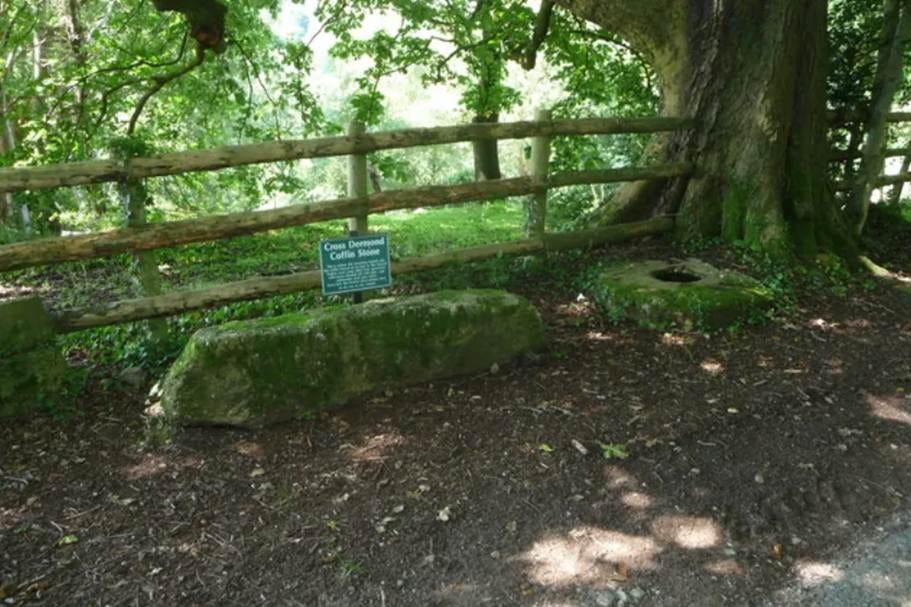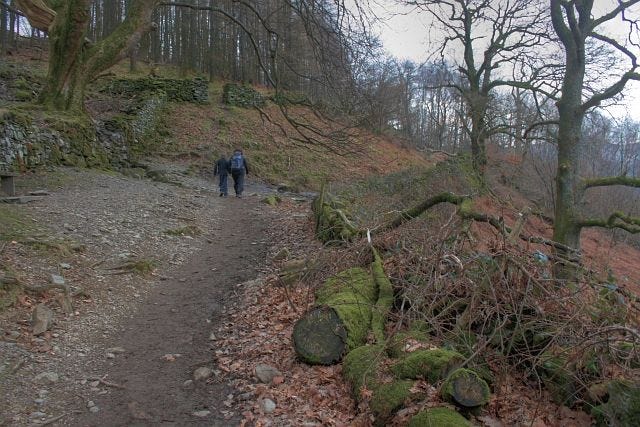Corpse Roads
Britain
Britain is crisscrossed with paths, many of which have histories of their own not least the corpse roads. Corpse roads, sometimes known as burial roads, coffin roads, lych ways, and lyke ways were used for exactly what it sounds like, transporting a corpse. Often found in rural areas these paths lead from remote dwellings to the parish churchyard.
On 22 March 1835 the Whitehaven Herald reported:
Deaths: On the 7th inst, at Pikeside, in Ulpha, Tamar, wife of Mr Myles Whinfied, aged 86. Owing to the great fall of snow, the corpse was obliged to be carried by a footpath, about 120 years ago used as the regular corpse road, but never since, except once about 60 years ago, the general cart road having been entirely blocked up, as is the case now.[1]
This snippet is telling. Pikeside is a farm outside the tiny village of Ulpha in the Lake District and clearly there was an old track that led from the farm down to the village which, as the newspaper noted, had not been used for at least 60 years. Clearly it was still a known route but one that was not traversable by cart.
If this route had been used half a century or more before then it seems corpse roads must have been in use at least from the mid-eighteenth century and conjecture would push this dating back even further. Unfortunately, dates of use for these paths are hard to come by. Newspaper evidence for these roads is wonderful, but they still rarely appear in records, even in newspaper sources, and much of the history of the routes lie in folklore and oral traditions or just practical observation.
Coffin stones were used by coffin bearers as a resting point. Jeremy Bolwell, The Cross Dermond Coffin Stone near Penallt (CC BY-SA 2.0)
Sometimes geographical features give evidence that a path was a corpse road such as the Cross Dermond Coffin Stone near Penallt (in the Wye Valley). These coffin stones were rest points along the route. In Scotland cairns were known to be erected along their corpse roads. ScotWays, a charity maintaining Scotland’s rights of public access, details how to find several coffin roads in its guidebook, Scottish Hill Tracks.
Normally six to eight men would accompany the corpse in its coffin along these paths, taking it in turns to hold the coffin. Though sometimes these paths are long they take direct routes, they were not created to enjoy the scenery, yet even then they twist and turn covering rough terrain and challenging landscapes. Sometimes other tracks from additional remote dwellings join up to the corpse road, as some roads served multiple areas.
The Coffin Roads by Ian Bradley looks at paths in the West Highlands and Hebrides. He has examined some of the more complex routes, those that involve crossings of lochs and the sea. ‘The places at which coffins were loaded onto boats and unloaded were often called either port nam marbh (the port of the dead) or carraig nam marbh (the rock of the dead, from the Gaelic word marbh meaning dead person or corpse’.[2] Therefore, these routes have left another marker in the form of place names.
Other corpse roads can only be guessed at. Until the late sixteenth century, the inhabitants of Killington and Firbank in Westmorland only had the option of burying their dead at Kirkby Lonsdale which was ten miles away. There must have been a corpse road between the locations, although it is no longer known, and by the seventeenth century other, closer churches and burial grounds were created.[3]
Given their purpose and the terrain they traverse, corpse roads have taken on significance within British folklore tales. Even Shakespeare played with this in one of Puck’s soliloquies.
Now it is the time of night
That the graves all gaping wide
Every one lets forth his sprite
In the Church Way Paths to glide
- A Midsummer Night’s Dream, Act 5, Scene 1
The secret history of these routes is hinted at here. Corpse candles and corpse lights, floating orbs along these routes have made their way into ghost stories and folk tales. The nineteenth century writer James Motley wrote of a corpse candle experience in 1848. He wrote that they:
seem to be of electrical origin, when the ears of the traveller's horse, the extremity of his whip, his spurs or any other projecting points appear tipped with pencils of light… the toes of the rider's boots, and even the tufts of hair at the fetlocks of his horse, appeared to burn with a steady blue light, and on the hand being extended, every finger immediately became tipped with fire.[4]
Whatever this was he survived it. As fascinating as these stories are, the practicality of a corpse road’s existence is equally as interesting and important. The intersections of folklore, landscape history, culture, and archaeology should all be considered when examining corpse roads and their history.
A Public Bridleway between Grasmere and Rydal, which takes its name from a time when Rydal was churchless and coffins had to be carried to the church at Grasmere. Mick Garrett, On the Coffin Path (CC BY-SA 2.0)
Clearly no longer used to transport the dead it is the living that may be traversing them now on country walks, and often without the knowledge of their past purpose. If you want to find some good routes there are a handful listed here. Many have been lost. When you are next out walking have a look and a think, could you be following in the footsteps of those carrying people to their final resting place?
References and Resources:
I. Bradley, The Coffin Roads: Journeys to the West (2022)
P. Bloomfield, ‘Guide to Britain’s Corpse Roads: history and the best coffin roads to visit’, Countryfile.
A. Cleaver and L. Park, The Corpse Roads of Cumbria: Walks along the country’s ancient paths (2022)
S. Dunn, ‘Corpse Roads: Digital Landscape Archaeology’ Gresham College (2020)
[1] Whitehaven Herald Sunday, 22 March 1835, seen in A. Cleaver and L. Park, The Corpse Roads of Cumbria: Walks along the country’s ancient paths (2022), 5.
[2] I. Bradley, The Coffin Roads: Journeys to the West (2022), 4.
[3] Cleaver and Park, The Corpse Roads of Cumbria, 3.
[4] J. Motley, Notes to the Canwyll Corph; Note 3 in Tales of the Cymry (1848), 112-115.





I'd never heard of corpse roads until I read this article. Thank you for opening a window to a part of history that fascinates me. While doing some further reading, I found this statement, which I found touching: "Among the Welsh it was reckoned fortunate for the deceased if it should rain while they were carrying him to church, that his bier might be wet with the dew of heaven."
Wow, that's so cool! Thanks, Anna!